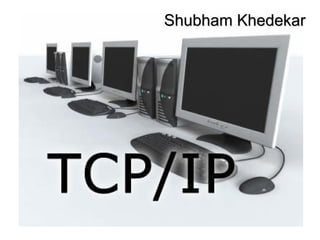
TCP/IP Protocols With All Layer Description
- 2. Introduction TCP/IPIntroduction TCP/IP The Internet Protocol Suite (commonly known as TCP/IP) is the set of communications protocols used for the Internet and other similar networks. It is named from two of the most important protocols in it: Transmission Control Protocol (TCP) and Internet Protocol (IP), which were the first two networking protocols defined in this standard.
- 4. APPLICATION LAYER This layer is comparable to the application, presentation, and session layers of the OSI model all combined into one. It provides a way for applications to have access to networked services. It is widely-known layer for the exchange of user information
- 5. The Hypertext Transfer Protocol (HTTP) is used to transfer files that make up the Web pages of the World Wide Web. The File Transfer Protocol (FTP) is used for interactive file transfer. The Simple Mail Transfer Protocol (SMTP) is used for the transfer of mail messages and attachments.
- 6. Presentation Layer does Encryption-Decryption and Compression-Decompression of Data. This layer allows a process to add checkpoints which are considered as synchronization points into stream of data.
- 8. TRANSPORT LAYER This layer acts as the delivery service used by the application layer. Two protocols used are TCP and UDP. The choice is made based on the application's transmission reliability requirements. The transport layer also handles all error detection and recovery.
- 9. It uses checksums, acknowledgements, and timeouts to control transmissions and end to end verification. Unlike the OSI model, TCP/IP treats reliability as an end-to-end problem TCP provides a one-to-one, connection-oriented, reliable communications service. UDP provides a one-to-one or one-to-many, connectionless, unreliable communications service.
- 10. A message is divided into segments; each segment contains sequence number, which enables this layer in reassembling the message.
- 11. Message is reassembled correctly upon arrival at the destination and replaces packets which were lost in transmission. Connection Control : It includes 2 types : 1. Connectionless Transport Layer : Each segment is considered as an independent packet and delivered to the transport layer at the destination machine. 2. Connection Oriented Transport Layer : Before delivering packets, connection is made with transport layer at the destination machine.
- 12. NETWORK LAYER This layer is also known as Internet Layer. The main purpose of this layer is to organize or handle the movement of data on network. By movement of data, we generally mean routing of data over the network. This layer is responsible for addressing, packaging, and routing functions.
- 13. The core protocols of the Internet layer are IP, ARP, ICMP, and IGMP. The Internet Protocol (IP) is a routable protocol responsible for IP addressing, routing, and the fragmentation and reassembly of packets. The Address Resolution Protocol (ARP) is responsible for the resolution of the Internet layer address to the Network Interface layer address such as a hardware address.
- 14. The Internet Control Message Protocol (ICMP) is responsible for providing diagnostic functions and reporting errors due to the unsuccessful delivery of IP packets. The Internet Group Management Protocol (IGMP) is responsible for the management of IP multicast groups.
- 15. It translates logical network address into physical address. Concerned with circuit, message or packet switching. Routers and gateways operate in the network layer.
- 17. DATA LINK LAYER Data link layer is most reliable node to node delivery of data. It forms frames from the packets that are received from network layer and gives it to physical layer. It also synchronizes the information which is to be transmitted over the data. Error controlling is easily done.
- 18. Protocols of this layer determine which of the devices has control over the link at any given time, when two or more devices are connected to the same link.
- 19. Error control is achieved by adding a trailer at the end of the frame. Duplication of frames are also prevented by using this mechanism. Frames are the streams of bits received from the network layer into manageable data units. This division of stream of bits is done by Data Link Layer.
- 20. Switch and Bridge are used in this layer
- 21. PHYSICAL LAYER Physical layer is the lowest layer of all. It is responsible for sending bits from one computer to another. This layer is not concerned with the meaning of the bits and deals with the physical connection This layer defines electrical and physical details represented as 0 or a 1.
- 22. This layer defines the rate of transmission which is the number of bits per second. It deals with the synchronization of the transmitter and receiver. The sender and receiver are synchronized at bit level. Devices must be connected using the following topologies: Mesh, Star, Ring and Bus.
- 23. Physical Layer defines the direction of transmission between two devices: Simplex, Half Duplex, Full Duplex
- 24. Deals with baseband and broadband transmission. Hubs and Repeater are used in this layer
